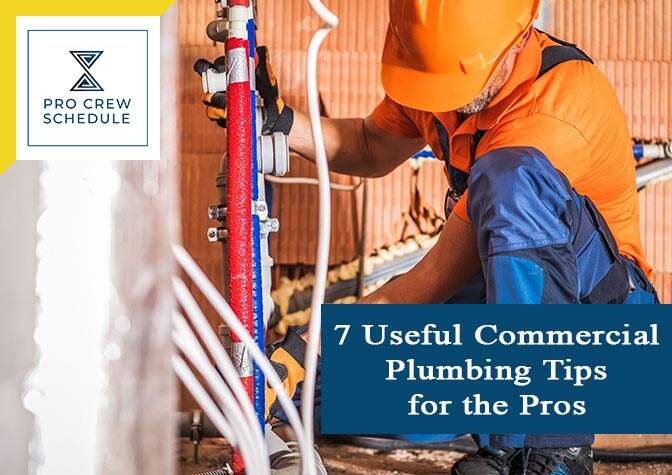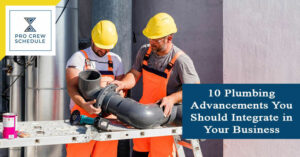As a professional commercial plumber, you are very used to getting called, especially during a crisis. When any of your client’s commercial properties have sudden plumbing issues like a water leak, you are requested right away. Ideally, a plumbing professional like you must stay ahead whenever issues occur before any of them becomes significantly complicated in your client’s business.
Most clients nowadays disregard the network of pipes being installed in their buildings or even any of the occurring issues unless when these problems are too complicated already. Plumbers must carry out regular inspections and maintenance immediately. As a professional plumber, allocating a little of your time and attention can undoubtedly extend the performance and service life of your client’s plumbing system.
Here are some helpful commercial plumbing tips that you can apply when maintaining commercial plumbing systems.
1. Look for any signs of trouble
During actual visits, it is efficient to walk around in the whole buildings, inspecting the exterior and interior to search for any water leak signs and damages. Even a small amount of spill can potentially qualify as water damage. A little water spot can eventually turn into a massive leak in the long run. In terms of commercial plumbing, any leaks will worsen since more wear and tear will occur in the system.
It is necessary to spot them as early as possible. Below are some common plumbing issues that most commercial buildings encounter.
- Faucet and Fixture Leaks
A leaky faucet typically costs money in every single drip. When wasting almost 3,000 gallons of water every year, the leaks are always caused by worn-out O-rings and gaskets or any other sealing mechanism failure. Water damage is a common issue that needs to be considered. On the other hand, a leaky fixture can destroy the areas surrounding it and cause structural damage if left unattended.
- Water Temperature Problems
Don’t have sufficient water? Too cold or hot water when washing hands? These are the common signs where the building’s water heater needs an immediate adjustment. If the water heater isn’t leaking, it is possibly failing. However, remember that not all leaks are the same or created equal. Hence, it would be best if you didn’t miss any leaky water heater or any block off valves or leaves.
Commercial water heaters certainly need maintenance and replacements like everything else. Only a very trained and experienced plumber like you can spot issues and fixing them. Make sure to prioritize project management for construction since it’ll produce a highly organized project outline, creating a seamless and unified platform for everyone involved.
- Clogged toilets and drains
Clogged drains and toilets are prevalent plumbing issues. Slow draining is typically the initial indication of a drain problem. Inspect the toilets of every restroom areas and determine if it requires constant plunging. Backups aren’t something anyone wanted to deal with, but you have to. Clogged drains usually mean there’s overflowing that happens. If there’s overflowing, then expect water damage.
- Silent leaks
Toilets leak silently 24/7, and nobody can notice it until when it is obvious, the same way that happens for fixtures and pipes. When wasting a thousand gallons of water per year, a leaking pipe and toilet can severely burn on the cash flow. Your client’s water bill will skyrocket. Firstly, plumbers like you should get every toilet tested and repair issues right away.
Using a cloud based application, everything is easily managed, from the most complicated tasks to the basic ones. Investing in any of the top industry trends today is worth it.
2. Basic Maintenance
As a professional plumber who wants to thrive, it is crucial to provide a basic maintenance routine whenever visiting a commercial property. When talking to a client about commercial buildings, you must firstly suggest basic preventative maintenance tasks. Doing so will make your clients efficiently prevented costly situations. Whether there are issues or not, you should visit often and execute thorough inspections.
Depending on the facility and plumbing, regular maintenance is worth scheduling. If buildings have hundreds of visitors every day, frequent maintenance is essential. Take note that plumbing is always a subject of wear and tear. Hence, the higher volume of traffic, the more should visit and inspect the plumbing system before any issues might occur.
Moreover, what services you may provide during maintenance visits will largely depend on the facility and plumbing. But, you must include the following:
- Ensuring there is enough usage of cold and hot water.
- Running all significant plumbing fixtures to ensure slow drains will not occur.
- Deploy subcontractor scheduling software to effectively manage everything, including projects and crew members.
- Running diagnostics to identify any signs of silent leaks.
- Checking the pressure gauge to make sure that water pressure usually is running.
- Ensuring all shut-off valves are operating correctly.
- Checking if there’s any risk of backflow in the water system.
- Making sure the water heater is running at the right temperature.
- · Wrap water pipes with insulation during the winter season to prevent issues like frozen pipes.
- Enzyme-based cleaners provide a better solution to clear clogged pipes.
- · Keep oily and greasy substances away from the sink as they might cause obstructions.
- Strainers can be used to prevent pipe obstructions and clear accumulated debris.
- Small plumbing issues can quickly turn into complicated ones. Never ignore any minor plumbing issues.
3. Plunge the Trap
One of the signs of skilled and experienced plumbing is a clean workspace. Once you learn and know how to adequately managed pipes where water can be found, it’ll very easy for you to make the next move. Repairing the trap under bathrooms is one of the standard plumbing works. Due to its shape, the trap always and almost creates a mess whenever being pulled.
Using a simple plunger, water can be removed easily. This work is usually easier to handle for pros like you. However, other more complicated issues will test your capability. To make sure you manage workloads smartly, invest in project management tools like Pro Crew Schedule! Not only it makes your work easier, but it also impacts your team’s productivity and collaboration.
Request for live demo! It’s openly free!
4. Reheating stuck pipes
Working with older pipes, significantly corroded, swelled, or rusted ones, often takes strong force to open. Even two opposing wrenches cannot budge an unresponsive connection sometimes. For water pipes, you have great options of pulling out a handheld blowtorch. By heating the hardened connection for a couple of minutes, you can easily loosen the bonds and gently pry the pieces free from one another.
5. Felt back pipe brackets
Particularly for cold-weather regions, any pipes running through and under the building will creak as they cool and heat from the weather. The creaking can often be attributed to a building becoming old or settling. However, it’s really about the quality of a plumbing installation. For high-quality plumbing service, it is smart to implement construction crew management. Members who collaborate firmly with one another produce excellent outcomes in both work and the services they offer.
The creaking is often caused by the contracting and expanding pipes scraping against the hanger brackets and walls. This happens mostly when the brackets are made from metal. Plumbers can increase the quiet of the buildings they currently work on, even without altering anything on the pipes. You can either wrap the pipes or line the brackets where they usually make contact, diminishing the possibility of grinding as the pipes cool and heat.
6. When Using Thread Tape and Dope
Thread tape and dope are considered two of the most critical parts of high-quality plumbing. It ensures that nothing will slip or leak while leaving fittings and pipes detach and attach when the time comes. Tapes have the advantage of not being messy and are ideal when working over carpets. However, they are only for threaded connections. That is why for best results, you can wrap the tape in a clockwise form so that it will unwrap as you start screwing the joints together.
Despite the mess’s risk, dope is very significant for nearly every plumbing solution, particularly if you have a set of dope tubes for various plumbing tasks and materials. It helps in sealing and settling compression fittings and in securing ground fittings. With dope that is both non-hardening and plastic-safe, you can quickly reinforce rubber seals, making repairs easier for the next years to come.
7. Replacing with Plastic
Not all plumbing parts have to be made of metal. In many cases, plastic has become a superior material compared to others. In fact, plastic pieces will free you from worrying about corrosion and rust while becoming more cost-effective than the metal counterparts. Whenever sourcing any replacement parts, especially for your service clients, you can favor both future repairs and current bills by merely switching the drain lines or any other doable parts out of new sturdy plastic mode.
Key Takeaways
Commercial plumbing is one of the most ignored aspects but is considered as one of the most important. Suppose something goes wrong within the system or its part, whether fixtures or components, it might bring a sudden and expensive halt to your client’s business. With the commercial plumbing tips cited above, preventing any plumbing issues from happening is easy.







